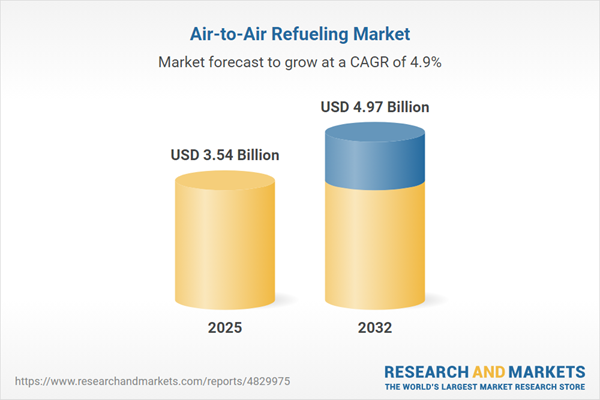Speak directly to the analyst to clarify any post sales queries you may have.
Air-to-air refueling stands as a vital enabler in modern defense and humanitarian operations, supporting sustained missions and extending global reach. Senior leaders require a clear view of the operational, technological, and geopolitical complexities shaping this evolving market.
Market Snapshot: Air-to-Air Refueling Market Size and Growth
The air-to-air refueling market grew from USD 3.37 billion in 2024 to USD 3.54 billion in 2025, with a projected CAGR of 4.94% to reach USD 4.97 billion by 2032.
Scope & Segmentation
This report comprehensively analyzes market segmentation, technological advancement, applications, and regional trends:
- Process Types: Flying boom (rigid boom, telescoping boom) and probe drogue (basket, fixed wingtip drogue, hose drum unit)
- Platform Types: Fighter aircraft (fifth generation, fourth generation), heavy and medium transport aircraft (aerial refueling tankers, cargo tankers, narrow and wide body), rotary wing aircraft (helicopters, tiltrotor aircraft), unmanned aerial vehicles (HALE and MALE UAVs)
- System Types: Boom (rigid, telescoping), pod, receptacle, wingtip drogue
- Fuel Types: Jet A1, JP-5, JP-8
- Application Areas: Firefighting, humanitarian, strategic, tactical, and training operations
- Operation Modes: Autonomous, manned, unmanned
- Regional Coverage: Americas (North America, Latin America), Europe, Middle East & Africa, Asia-Pacific
- Key Industry Participants: The Boeing Company, Airbus SE, Lockheed Martin, Northrop Grumman, Raytheon Technologies, Cobham PLC, Eaton, KBR, Elbit Systems, Leonardo S.p.A.
Emerging Technologies in Air-to-Air Refueling
- Autonomous docking and refueling solutions are enabling unmanned aerial vehicle integration and reducing pilot burden.
- Digital management platforms provide in-depth fuel analytics, telemetry, and predictive maintenance.
- Advanced materials and additive manufacturing improve the strength, efficiency, and longevity of refueling components.
- Sustainable aviation fuels are under evaluation to reduce environmental impact and extend equipment lifespans.
Key Takeaways for Decision-Makers
- Airborne connectivity is now a core strategic imperative for defense, supporting rapid force projection and timely humanitarian interventions.
- Successful integration within multinational coalitions requires rigorous interoperability standards and synchronized procedures across allied fleets.
- Threat evolution in contested environments demands adaptable electronic warfare resilience and dynamic deconfliction protocols for refueling assets.
- Holistic operational solutions, encompassing real-time mission planning and end-to-end fuel management, ensure mission continuity and safety.
- Platform, process, and fuel segmentation drive the need for tailored procurement and training strategies, crucial for optimal operational outcomes.
- Collaborative supply chain and training investments support both resilient logistics and rapid response capability across regions.
Tariff Impact on Global Supply Chains
Recent U.S. tariff policies have increased production costs and lead times for air-to-air refueling systems by impacting internationally sourced components. Procurement teams are responding by shifting to domestic fabrication where feasible, strengthening local partnerships, and adapting joint ventures. Industry leaders are prioritizing vertical integration and supplier diversification to secure mission-critical parts and maintain program schedules. These moves enhance transparency and mitigate future geopolitical risks throughout the supply network.
Methodology & Data Sources
This analysis combines primary research with in-depth interviews of defense procurement authorities and system integrators, complemented by secondary sources such as official white papers, patent filings, and supply chain data. Quantitative validation and independent case studies ensure robust, actionable insights for strategic planning.
Why This Report Matters
- Supports informed capital allocation and procurement decisions in complex, rapidly evolving operational and regulatory environments.
- Enables benchmarking of technological innovation, interoperability, and regional adoption trends for a competitive edge.
- Provides actionable guidance for strengthening supply chains, workforce training, and technology roadmaps.
Conclusion
Air-to-air refueling will remain central to defense and humanitarian reach through continual innovation and resilient operational paradigms. Stakeholders positioned for adaptability and collaboration will be best prepared to meet future demands and uncertainties.
Additional Product Information:
- Purchase of this report includes 1 year online access with quarterly updates.
- This report can be updated on request. Please contact our Customer Experience team using the Ask a Question widget on our website.
Table of Contents
3. Executive Summary
4. Market Overview
7. Cumulative Impact of Artificial Intelligence 2025
Companies Mentioned
The companies profiled in this Air-to-Air Refueling market report include:- The Boeing Company
- Airbus SE
- Lockheed Martin Corporation
- Northrop Grumman Corporation
- Raytheon Technologies Corporation
- Cobham PLC
- Eaton Corporation plc
- KBR, Inc.
- Elbit Systems Ltd.
- Leonardo S.p.A.
Table Information
| Report Attribute | Details |
|---|---|
| No. of Pages | 198 |
| Published | October 2025 |
| Forecast Period | 2025 - 2032 |
| Estimated Market Value ( USD | $ 3.54 Billion |
| Forecasted Market Value ( USD | $ 4.97 Billion |
| Compound Annual Growth Rate | 4.9% |
| Regions Covered | Global |
| No. of Companies Mentioned | 11 |









